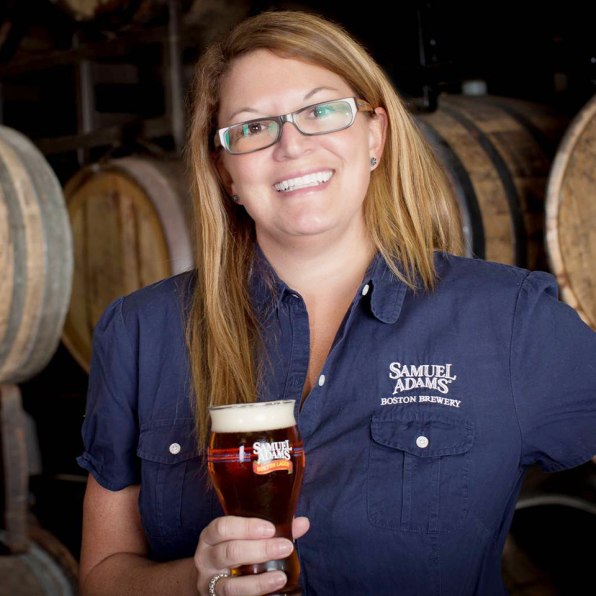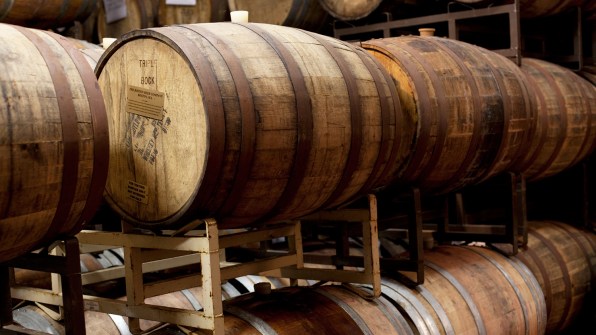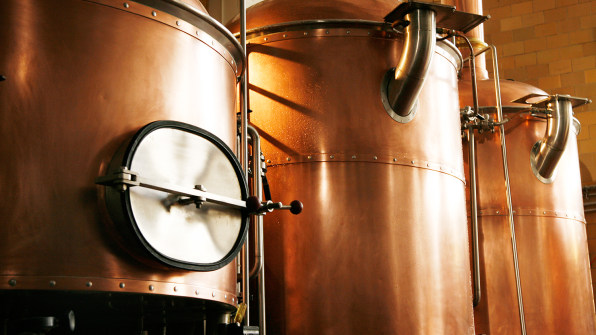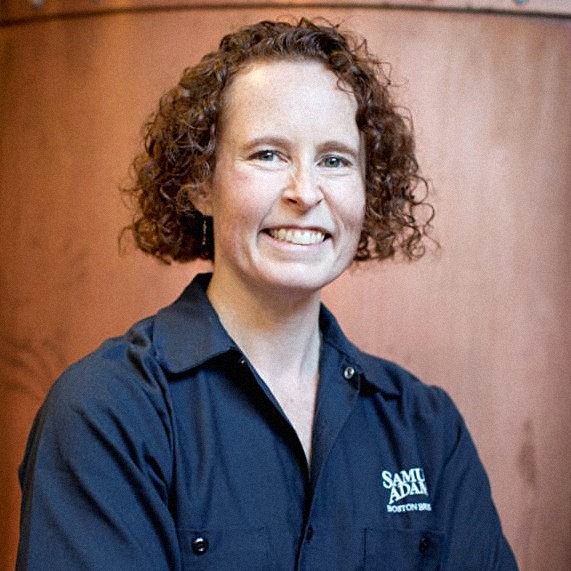How to Master the Art of Selling Sam Adams
Off the coast of Finland, tucked away on sunken ninth-century Viking ships, divers have found bottles of an aboriginal ale called sahti. Information technology is one of the oldest continually brewed beers in the world. According to historical records, women were the ones who concocted the beverage in farmhouses while the men went off to explore the world and fight battles. Sahti recipes oft passed from mother to daughter through generations.
About a decade ago, the story of sahti captured Jennifer Glanville'southward imagination. As the brewery director at Samuel Adams in Boston, she creates 60 new beers every yr alongside a team of 25 beer makers. Eager to re-create sahti, she learned that the original brewers would age the beer on a bed of juniper branches with berries still fastened. Glanville and another female person brewer managed to replicate this process and produce a citrusy sahti that was an instant hit with early on tasters. For years she had made just enough of her brews to serve visitors to the brewery and coworkers. But Sam Adams released Glanville's sahti as a limited edition nationally in 2011, nether the proper name Norse Fable.

Glanville, who has been working at Sam Adams for 15 years, has played a key role in helping the make continue upwards with the changing tastes of the American beer drinker. She's launched the Nano-Brewery, which serves as a lab for all kinds of cool experiments. She's imported massive casks to create Belgian-mode aged beers. And she's ensured that at least half of all brewers are female person because she believes that diversity improves the beer-making process. Equally the sahti saga reminds us, women accept had a long history of making delicious beer.
Sam Adams was founded in 1984 past Jim Koch, a man who earned 3 degrees at Harvard and landed jobs in finance and consulting before jumping ship to pursue his real passion: beer. When he concocted his signature Boston Lager in his kitchen, the concept of the microbrew was withal novel in America. Throughout the 1970s, there were fewer than 100 breweries in the unabridged country, and the market was controlled by Coors, Budweiser, and Miller. But as Koch went from bar to bar selling his small batch of beer, he discovered that at that place was a budding involvement in craft brews.
In 1985, he moved into the former Haffenreffer Beer brewery, built in 1870. In that historic space, Koch started to make beers that many believe launched America's craft beer revolution. He named the visitor Samuel Adams, inspired by that other great Boston revolutionary who as well happened to brand beer.
These days, Sam Adams has lost a bit of its mojo among the thousands of new craft brews that have flooded the marketplace. Three new beer makers set up shop every day, and the total number of breweries in the U.Due south. has doubled over the past four years to 4,200. According to the Brewers Association, the concluding time at that place were this many breweries in the country was in 1873, when each individual pub manufactured its own beverages. In this new landscape, Sam Adams isn't as hip as information technology in one case was.
Craft drinkers now have thousands of intriguing new options to choose from, and in this saturated marketplace, Sam Adams has struggled to reassert itself as unique. Information technology doesn't help that the make did so well in the '90s and early '00s that it became ubiquitous; Koch took his business public in 1995. Today, the visitor manufactures 4.1 meg barrels and has seen profits continue to increase. Its stock price is currently up 15%.
Simply for all its success, Sam Adams is withal losing market share. That's where Jennifer Glanville comes in.

Glanville joined Sam Adams in 2001 during the dotcom bust, when her career in the tech sector began to fizzle out. Having seen how chop-chop money ebbed and flowed during the tech bubble, she decided to focus on finding an occupation that would make her happy rather than rich. She chanced upon a posting for the brewery manager task and since she loves beer—particularly Boston Lager—she practical. "The task description had everything from beer inventory management to organizing tours of the brewery to driving a forklift," she says. "Everything except actual brewing."
Koch was impressed with Glanville's passion for beer and decided to adventure on her. Later on a year in the position, he sent her to Doemens Academy, a well-known brewing school in Germany, so she could larn the art of beer making.
Upon her return, she took on more responsibility, helping Koch create new beers, expanding the team from 9 people to 25, and developing innovative new systems that would assist Sam Adams compete in the market place.
Glanville says that creativity has always been office of the corporate culture. "I think it has to do with the fact that the company was started by an entrepreneur," she says. "All of us at the brewery are coming upwardly with new ideas all the time, and [Jim] has always encouraged united states to try to turn them into beer."
Some of the company's best-selling beers have come from random ideas that staff members take thrown around. Glanville has her own repertoire of greatest hits. A decade agone, for case, she thought it might be fun to create pumpkin beer for the company Halloween party. "This was well before the pumpkin beer craze," she says. "Nobody at the brewery thought it was a good thought."
She was determined to make it work. She found a local caterer who helped her roast mountains of pumpkins, then carried the trays over past hand to the brewery. The beer she created concluded up being a holiday favorite at the staff party, and then she kept making information technology for the squad until 2005, when Sam Adams launched the Fat Jack Pumpkin Ale nationally.
Glanville's dear of Wellfleet Oysters inspired her to test out brewing with the whole mollusk, shell and all. That experiment yielded a stout that is sold at Boston'southward famous Union Oyster House and has go a staple at local festivals.
Glanville points out that every one of the six brewers at Sam Adams has similar stories of experiments that take evolved into love, nationally distributed varieties. It'south such a small, collaborative surroundings that information technology's often hard to decide who should accept credit. "People frequently asked who came upward with the beer," she says. "The truth is, we all do information technology together. Nosotros throw a lot of ideas against the wall. They don't always stick in their original format, but it'south that spirit that keeps us making innovative beers."

In 2012, Glanville helped set the Nano-Brewery to incorporate innovation into the actual brewing process, much similar a microbrewery does. Every twenty-four hours, Sam Adams brewers use the Nano as a lab for experimenting with new flavors, textures, and processes. Some projects are simply nigh incremental improvement: how to tweak a recipe to make a beer tarter, more citrusy, or with a less overwhelming aroma. But some projects are about creating something entirely new and different annihilation else on the market.
A year ago, Sam Adams hired Megan Parisi, a master brewer with years of experience on the craft beer circuit, to run the Nano. The day I visit the brewery, Glanville and Parisi accept been working to perfect a plum beer made in a Belgian-fashion pale ale style known as a saison. They pour me a glass from one of the 30 beers on tap that are in various stages of testing. I'm not a big fan of beer, only this is unlike annihilation I've tasted before. It'south a little sugariness and fruity, just not cloying. Information technology's moderately carbonated, so the bubbles don't overwhelm you. And it'due south light and refreshing, perfect for a hot summer day.

Parisi is very scientific near these experiments. Every ingredient and each pace is recorded on a estimator, then that when a recipe hits the mark, she is able to replicate it. Beers that the brewers think are set up for prime fourth dimension will get brewed in small-scale batches, so served to the 250,000 or and so visitors who come to the brewery every twelvemonth. These guests serve as a focus group of sorts, providing formal feedback. And beers that do well with drinkers end up among the threescore beers that Sam Adams releases for retail annually.
One of the Nano'south contempo successes with critics and consumers is the Nitro Project. Released earlier this year, the beers come in cans with widgets that activate upon opening, infusing the beverage with a flossy texture. While nitrogenation has been frequently used in stouts (retrieve Guinness), information technology isn't establish in wheat beers or pale ales—until at present. Sam Adams has released a trio of beers including an IPA, a white ale, and a coffee stout. I try all of them. The white ale is my favorite: As yous pop open the can and pour it into a mug, it fills with froth that cascades downward. This makes the beer very shine, merely it also brings out some of the subtle flavors that you lot might non otherwise gustatory modality, like the citrus and pepper undercurrents.

Every bit the end of my visit nears, I sit around a table with four female master brewers who are sampling beers that are being developed. They take notes virtually flavors, aromas, and terminate, and so hash out what needs to happen to turn them into finished products.
Earlier in the solar day, Glanville explains that the visitor's approach is to hire the best people for the job, rather than fill quotas. Nonetheless, she says that she tends to attract female job candidates. And of a full staff of 25 people, 50% are women. While at that place isn't a manner to quantify how this affects the culture and inventiveness at the brewery, Glanville believes that information technology helps create a diversity of palates amongst her brewers. (In that location'due south some testify that men and women have dissimilar perceptions of taste.)
Will all these efforts transform Sam Adams into the arts and crafts-brewing sensation it once was? Perhaps. The beer landscape in this country is forever changed. Years ago, a drinker would profess a loyalty to a particular brand, but today'south consumer is promiscuous, preferring to sample new products.
"There was a time when people wouldn't want to gild a beer they were unfamiliar with in case they didn't like it," Glanville says. "But at present, they'll walk into a liquor store and buy an entire 6-pack they've never tried before, willing to take a risk on it."
Glanville believes that the only way to respond to this brave new world is to go on coming up with exciting new offerings that will spark people's involvement when they see it on a shelf or on tap—without ever compromising the arts and crafts or the quality. "People come to us because they trust the quality of our product," she says. "We simply need to keep giving them new flavors to try."
Source: https://www.fastcompany.com/3061422/a-wizardly-brewmaster-pursues-the-perfect-craft-beer-at-sam-adams